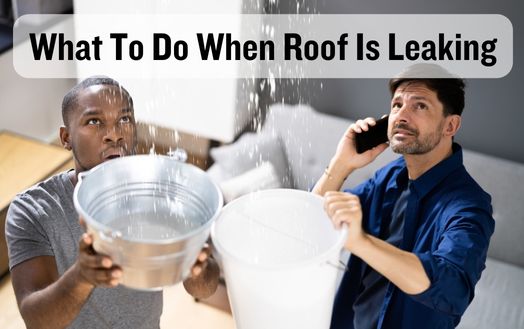As I sat in my living room, enjoying a cup of tea and watching the rain pour outside, I couldn’t help but notice a steady drip coming from the ceiling. Panic set in as I realized that my roof was leaking, and I knew I had to act fast.
But where should I start? What steps should I take to tackle this daunting problem?
Well, fear not, because in this discussion, I will guide you through the necessary actions on what to do when roof is leaking. Trust me, you won’t want to miss out on these invaluable tips to protect your home and belongings.
Assess The Extent Of The Damage
To fix a leaking roof, I must assess the damage. Leaks in your home can cause significant water damage, threatening its structure. I’ve developed an innovative way to efficiently assess damage and plan a targeted repair strategy.
The leak source must be found first. This may require a thorough roof inspection for cracked or missing shingles, deteriorated flashing, or damaged vent and chimney seals. We can save time and resources by focusing on water entry points.
The severity of the damage must be assessed next. Do you have ceiling water stains or structural damage from the leak? By carefully inspecting the damaged areas, we can assess the damage and prioritize repairs. This novel method prioritizes the most pressing issues, preventing further damage and leaks.
I use advanced technology to assess water damage beyond visual inspection. Moisture meters and thermal imaging cameras help me find hidden moisture and urgent areas. These cutting-edge tools and traditional inspection methods allow us to assess the damage and create a customized roof repair plan.
Locate The Source Of The Leak
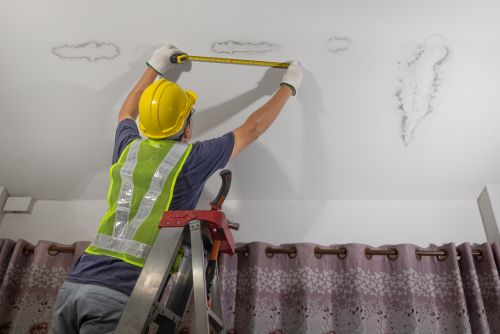
First, I carefully inspect the roof to find the leak. Finding the leak is essential to fixing it and preventing further roof and house damage. How to find the leak source:
External Inspection
- Start by visually examining the roof from the ground. Look for any visible signs of damage, such as missing or damaged shingles, cracks, or holes.
- Next, use a ladder to safely access the roof and conduct a closer inspection. Pay close attention to areas where different roof materials meet, such as valleys, vents, and chimneys. These areas are common sources of leaks.
Internal Inspection
- Once you have inspected the exterior of the roof, it’s time to move indoors. Look for any signs of water damage on the ceiling, walls, or around windows and skylights.
- Trace the path of the water damage to find the highest point where it’s occurring. This will give you a better idea of where the leak is originating from.
Modern technology innovates in leak detection. Infrared cameras and moisture meters can find leaks and moisture buildup that aren’t visible. This cutting-edge leak detection equipment saves time and money.
Temporarily Patch The Leak
A roof leak can be temporarily fixed with a patch. Leaking roofs require immediate action to prevent home damage. Temporary patches can help until a roofer arrives.
As mentioned in the previous subtopic, you must find the leak source to temporarily patch it. After finding the problem, gather roofing cement, a putty knife, and tarp or roofing felt for patching.
Clear the leaky area of debris and loose shingles. Use the putty knife to apply generous roofing cement to the affected area. Spread cement evenly for a watertight seal.
Next, cut a patching material slightly larger than the damage. Press the patch firmly onto the cemented area. Smooth out wrinkles and air bubbles for a tight seal.
This is only a temporary fix; professional roof repair is needed. To avoid mold and other health risks, fix the leak’s cause.
Remove Any Standing Water
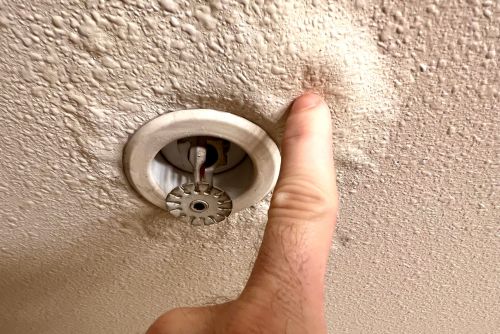
After temporarily patching the roof leak, remove any standing water. Standing water must be removed to prevent further water damage and repair the roof. Innovative ways to remove standing water from a leaking roof:
- Install a sump pump: A sump pump is a device that helps remove water from basements and crawl spaces. By installing a sump pump in your attic or on the affected area of your roof, you can effectively remove standing water and prevent it from causing structural damage.
- Utilize a water absorbent material: Innovative water absorbent materials, such as moisture-absorbing mats or towels, can be placed strategically on the leaking roof to soak up standing water. These materials can absorb large amounts of water, helping to dry out the affected area.
- Use a dehumidifier: A dehumidifier can be a valuable tool in removing excess moisture from the air and accelerating the drying process. By running a dehumidifier in the area affected by the leak, you can help prevent mold and mildew growth.
- Employ infrared technology: Infrared technology can be used to detect hidden moisture in your roof. By using an infrared camera, you can identify areas with excessive moisture and target them for water removal.
Protect Your Belongings
Prevent roof leaks from damaging your belongings. Water intrusion can cause costly or irreversible damage to your valuables. Here are some creative ways to protect your belongings from roof leaks.
Most importantly, inspect your attic regularly. Dampness, mold, or ceiling or wall discoloration may indicate water damage. Fix any problems immediately to avoid further damage. A water detection system in your attic can alert you to leaks and moisture buildup, so you can act quickly.
Take direct action to protect your belongings. Store valuable items like photos, documents, and electronics in plastic or waterproof bins. These containers prevent water damage to your belongings. Elevating furniture and other items off the floor reduces water damage.
Additionally, make sure your insurance policy covers roof leaks and water damage. Consider adding coverage if your policy has exclusions. Take pictures or videos of your belongings to make filing a claim and getting compensation easier.
Document The Damage
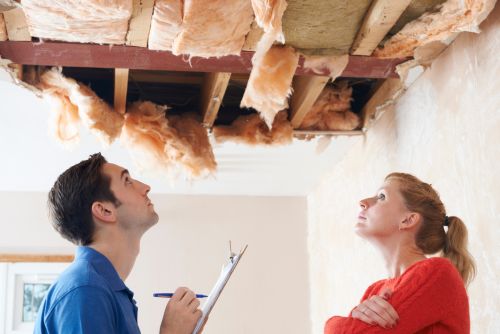
Protecting your investment from a leaking roof requires inspecting and documenting your belongings. Leaking roofs require immediate action to minimize damage. Innovative ways to document damage and streamline insurance claims:
- Take detailed photographs: Use your smartphone or camera to capture clear and high-resolution images of the affected areas. Make sure to take shots from different angles to provide a comprehensive view of the damage. This visual evidence will help your insurance adjuster assess the extent of the roof’s leak and expedite your claim.
- Pro tip: Use a measuring tape or ruler in the photos to provide a sense of scale for the damage.
- Create a detailed inventory: Make a list of the damaged items and their current condition. Include relevant details such as brand, model, purchase date, and estimated value. This inventory will serve as a valuable reference when filing your insurance claim and ensure that you receive proper compensation for your damaged belongings.
- Pro tip: Utilize digital tools like spreadsheets or cloud-based inventory apps to easily organize and update your inventory.*
Contact A Professional Roofer
First on what to do when roof is leaking, contact a professional roofer immediately to assess and repair the leaking roof. Roof issues require a roofing professional. DIY repairs may cause more damage or ineffective repairs, resulting in more expensive repairs.
Leaking roofs are serious issues. Water, mold, and structural damage can result from ignoring or delaying repairs. Contacting a professional roofer immediately can prevent these issues from worsening and get your damaged area treated.
A skilled roofer will inspect your roof to find the leak. Their expertise allows them to identify leak causes like damaged flashing or missing shingles. After finding the leak, they’ll explain the issue and suggest the best solution.
Sometimes a simple repair can fix the leak. A roof replacement may be needed if the damage is extensive or the roof is old and deteriorating. An experienced roofer can help you choose the best option for your situation.
File An Insurance Claim
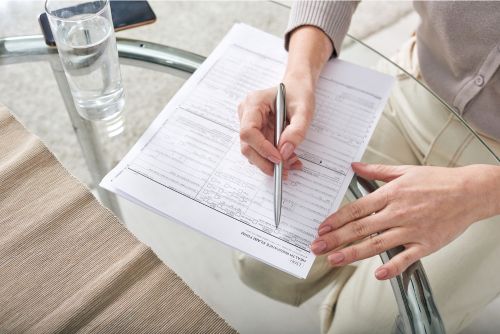
To get financial aid for a leaking roof, file an insurance claim. Consider these factors when filing an insurance claim:
- Documentation is essential: Gather all necessary documentation, such as photos or videos of the damage and receipts for temporary repairs or expenses.
- Engage a professional roofing contractor: Hire a reputable roofing contractor to assess the damage, provide a detailed report, and give an estimate for necessary repairs or replacements.
- Communicate with your insurance provider: Contact your insurance agent or company as soon as possible to report the leak and provide them with all relevant information.
- Cooperate with the claims adjuster: Be present during the claims adjuster’s inspection and provide any additional information they may need.
- Stay organized and follow up: Keep all paperwork, emails, and correspondence organized and follow up with your insurance provider regularly.
Prevent Future Leaks
Fix any roof maintenance issues to prevent leaks. Roofs need regular inspection and maintenance to last. By being proactive, you can avoid costly repairs and property damage.
Hire a professional roofer to inspect your roof first. They’ll identify issues and suggest repairs or replacements. This will keep your roof in good condition and prevent leaks.
Roof material selection is also crucial. Improved roofing technology has produced more durable and water-resistant materials. Selecting high-quality roofing materials can greatly reduce leaks and property damage.
Leak prevention requires regular maintenance. Clean your roof to avoid water pooling and seepage from clogged gutters and drains. Keep overhanging tree branches from damaging the roof by trimming them.
Regularly Inspect And Maintain Your Roof
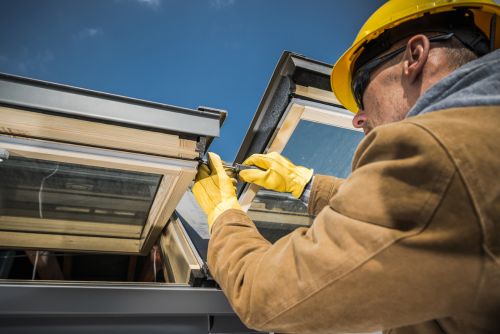
To prevent leaks and prolong roof life, inspect and maintain it regularly. A few simple steps can keep your roof in good condition and prevent costly repairs. Innovative roof inspection and maintenance methods:
- Conduct visual inspections: Take the time to visually inspect your roof at least once a year, or after severe weather events. Look for any signs of damage, such as cracked shingles, missing tiles, or sagging areas. Addressing these issues promptly can prevent further damage and potential leaks.
- Clean your gutters: Clogged gutters can lead to water pooling on your roof, increasing the risk of leaks. Regularly clean out your gutters and ensure they’re free from debris. Consider installing gutter guards to prevent clogs and reduce maintenance.
- Trim overhanging branches: Overhanging branches can scrape against your roof, causing damage to the shingles. Trim any branches that are in close proximity to your roof to prevent this potential source of leaks.
- Check seals and flashing: Inspect the seals around vents, chimneys, and skylights, as well as the flashing around these areas. Ensure they’re intact and properly sealed to prevent water from seeping in.
- Schedule professional inspections: While regular visual inspections are important, it’s also beneficial to have a professional inspect your roof every few years. They can identify any hidden issues and provide recommendations for maintenance or repairs.
You must inspect and maintain your roof to prevent leaks and extend its lifespan. These innovative steps will keep your roof in great shape, protecting your home from water damage and costly repairs.
Final Thoughts
When dealing with a leaking roof, it’s important to take immediate action to assess the damage, locate the source of the leak, and patch it temporarily. Removing any standing water and protecting your belongings are crucial steps.
Contacting a professional roofer and filing an insurance claim are essential for long-term solutions. To prevent future leaks, regularly inspect and maintain your roof. Remember, taking proactive measures can save you from costly repairs in the future. So now you already know what to do when roof is leaking.
Frequently Asked Questions
How Do I Know If My Roof Is Leaking?
I look for water stains on the ceiling or walls, dampness or mold in the attic, or ceiling dripping to see if my roof is leaking. These signs suggest a leak.
The issue must be addressed immediately to avoid further damage. Regular inspections and maintenance can spot leaks before they become major issues.
Can I Fix A Roof Leak Myself?
I can definitely fix a roof leak myself. It’s important to assess the severity of the leak first. If it’s a minor issue, like a loose shingle or a small hole, I can easily patch it up using roofing sealant or a patch kit.
However, for more complex leaks or larger damage, it’s best to consult a professional. But with some basic DIY skills and the right materials, I can tackle most roof leaks on my own.
Is A Leaking Roof Covered By Homeowners Insurance?
Does homeowner’s insurance cover roof leaks? Leaking roofs are usually covered by homeowner’s insurance. You should review your policy to understand its coverage and exclusions. If your roof leaks, call your insurer and take pictures or videos. They will help you file claims and arrange repairs.
How Long Does It Take To Repair A Roof Leak?
Well, it depends on various factors such as the extent of the damage and the availability of materials and labor.
In some cases, a roof leak can be fixed within a few hours or days, while more complex repairs may take several weeks. It’s essential to hire a professional roofer who can assess the situation and provide an accurate estimate of the repair timeline.
What Are The Common Causes Of Roof Leaks?
Common causes of roof leaks include:
- Damaged or missing shingles
- Cracked flashing
- Clogged gutters
- Inadequate roof ventilation
These issues can lead to water seeping into your home, causing damage to the interior and potentially compromising the structural integrity of the roof.
It’s important to address these issues promptly to prevent further damage. Regular roof inspections and maintenance can help identify and resolve potential problems before they turn into costly leaks.

